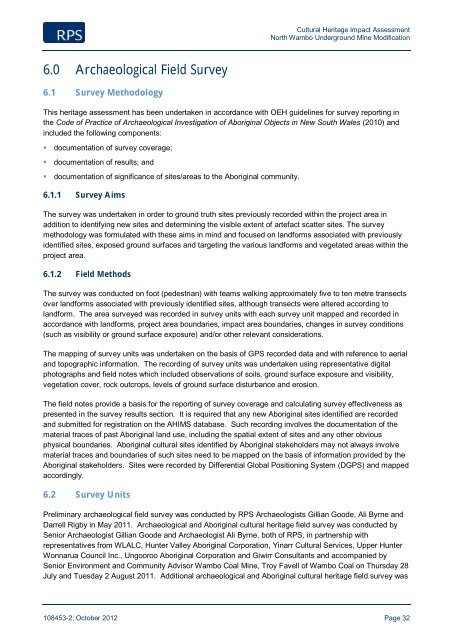Appendix C - Cultural Heritage Impact Assessment - Peabody Energy
Appendix C - Cultural Heritage Impact Assessment - Peabody Energy
Appendix C - Cultural Heritage Impact Assessment - Peabody Energy
Create successful ePaper yourself
Turn your PDF publications into a flip-book with our unique Google optimized e-Paper software.
<strong>Cultural</strong> <strong>Heritage</strong> <strong>Impact</strong> <strong>Assessment</strong><br />
North Wambo Underground Mine Modification<br />
6.0 Archaeological Field Survey<br />
6.1 Survey Methodology<br />
This heritage assessment has been undertaken in accordance with OEH guidelines for survey reporting in<br />
the Code of Practice of Archaeological Investigation of Aboriginal Objects in New South Wales (2010) and<br />
included the following components:<br />
• documentation of survey coverage;<br />
• documentation of results; and<br />
• documentation of significance of sites/areas to the Aboriginal community.<br />
6.1.1 Survey Aims<br />
The survey was undertaken in order to ground truth sites previously recorded within the project area in<br />
addition to identifying new sites and determining the visible extent of artefact scatter sites. The survey<br />
methodology was formulated with these aims in mind and focused on landforms associated with previously<br />
identified sites, exposed ground surfaces and targeting the various landforms and vegetated areas within the<br />
project area.<br />
6.1.2 Field Methods<br />
The survey was conducted on foot (pedestrian) with teams walking approximately five to ten metre transects<br />
over landforms associated with previously identified sites, although transects were altered according to<br />
landform. The area surveyed was recorded in survey units with each survey unit mapped and recorded in<br />
accordance with landforms, project area boundaries, impact area boundaries, changes in survey conditions<br />
(such as visibility or ground surface exposure) and/or other relevant considerations.<br />
The mapping of survey units was undertaken on the basis of GPS recorded data and with reference to aerial<br />
and topographic information. The recording of survey units was undertaken using representative digital<br />
photographs and field notes which included observations of soils, ground surface exposure and visibility,<br />
vegetation cover, rock outcrops, levels of ground surface disturbance and erosion.<br />
The field notes provide a basis for the reporting of survey coverage and calculating survey effectiveness as<br />
presented in the survey results section. It is required that any new Aboriginal sites identified are recorded<br />
and submitted for registration on the AHIMS database. Such recording involves the documentation of the<br />
material traces of past Aboriginal land use, including the spatial extent of sites and any other obvious<br />
physical boundaries. Aboriginal cultural sites identified by Aboriginal stakeholders may not always involve<br />
material traces and boundaries of such sites need to be mapped on the basis of information provided by the<br />
Aboriginal stakeholders. Sites were recorded by Differential Global Positioning System (DGPS) and mapped<br />
accordingly.<br />
6.2 Survey Units<br />
Preliminary archaeological field survey was conducted by RPS Archaeologists Gillian Goode, Ali Byrne and<br />
Darrell Rigby in May 2011. Archaeological and Aboriginal cultural heritage field survey was conducted by<br />
Senior Archaeologist Gillian Goode and Archaeologist Ali Byrne, both of RPS, in partnership with<br />
representatives from WLALC, Hunter Valley Aboriginal Corporation, Yinarr <strong>Cultural</strong> Services, Upper Hunter<br />
Wonnarua Council Inc., Ungooroo Aboriginal Corporation and Giwirr Consultants and accompanied by<br />
Senior Environment and Community Advisor Wambo Coal Mine, Troy Favell of Wambo Coal on Thursday 28<br />
July and Tuesday 2 August 2011. Additional archaeological and Aboriginal cultural heritage field survey was<br />
108453-2; October 2012 Page 32

















